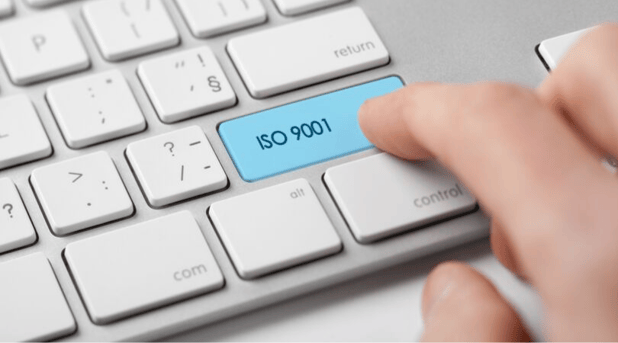
If an organization advertises themselves as ISO 9001 Certified, this company has met the requirements listed under ISO 9001. In order to keep up with ISO 9001 standards, many companies find a quality management system (QMS) to be a necessity. A QMS is a collection of business functions that work to continuously improve your company’s quality to ensure customer expectations are met. Let’s take a closer look at how a QMS improves ISO 9001 management by reducing human error within your business, reducing the costs your company expends to improve quality, and helping guarantee you meet compliance standards.
What is ISO 9001?
ISO 9001 standards require organizations to define and follow a quality management process that is effective as well as expecting them to identify areas for improvement and take action toward those adjustments. As a result, it is typically understood that an organization claiming ISO 9001 certification is an organization with products and services that meet quality standards.
There have been multiple updates to the ISO 9001 requirements, the most recent being in 2015. ISO 9001:2015 standards are based on the plan-do-check-act method and provide a detailed approach to documenting and reviewing the responsibilities and procedures required to achieve effective quality management. Specific sections of the standard contain information on the following topics:
- Responsibilities of management
- Management of resources, including human resources and an organization’s work environment
- Product realization, including the steps from design to delivery
- Measurement, analysis, and improvement of quality management processes through activities like internal audits and corrective and preventive action
Attempting to meet these standards is extremely challenging without some sort of quality management system. So, let’s get into exactly how a QMS can improve your business’s ISO 9001 management.
Ways that a QMS Improves ISO 9001 Management
Reduces human error
ISO 9001:2015 includes one important section that states: “The organization shall implement production and service provision under controlled conditions. Controlled conditions shall include, as applicable: … the implementation of actions to prevent human error”. In any organization, human error is inevitable, but there are tools available to minimize these occurrences and make adhering to ISO standards much easier.
Many companies still rely on manual data entry and other functions that are prone to human error. With a traditional system, employees are collecting information on paper and then transferring this data into an electronic document management system. A QMS eliminates the need for paper data entry and turns a two-step process into one simple step. Workers can collect data on a convenient electronic device in real time and diminish the risk of common transfer errors.
A QMS can reduce both the frequency and the severity of human errors using the following capabilities:
- Documents can be drafted, approved and controlled within the QMS software where there is a complete document history of who did what and when to every document
- Document procedures for dealing with actual and potential non-conformances with electronic NCR forms and reportable action items for employees
Under a quality management system, each employee works towards measurable objectives. Human errors are diminished, and workers have a straightforward idea of what their quality objectives are on a daily basis, ensuring that the organization complies with this section of ISO 9001:2015.
Reduce cost of quality
In the process of reducing human error and remaining compliant with industry standards, keeping up with ISO 9001 can seem difficult and costly. However, a QMS can actually reduce your company’s quality costs while keeping you in line with these requirements using these features:
- QMS reports provide quality assurance managers with live metrics and data being collected with your company allowing managers to hone in on areas of your production and quality process that are inefficient.
- Regularly audit and evaluate your quality system for conformance and effectiveness using through periodic review cycles that automate the routine evaluation of documentation
- Assure the quality of your products and perform root cause analysis to continue improving processes with electronic CAPA forms
- Employee training that enforces the reading and comprehension of documents, to guarantee the quality policy is understood and followed at all levels and by all employees.
Using these capabilities, your systems are optimized more tactically and quickly, easily identifying inefficient areas and reducing wasteful production errors. And by lowering instances of poor quality outputs, your company’s overall cost of quality will be reduced right along with it.
Meet compliance standards
Of course, the most important function of a QMS is its ability to help your organization meet compliance standards. The process of tracking and adhering to ISO requirements can be overwhelming for an organization that does not have a quality management system in place. By implementing a QMS, your organization will have the necessary tools to meet ISO 9001 certification requirements using the following features:
- Internally audit your organization’s compliance through electronic forms where data can be extracted for reporting purposes, including action items and periodic reviews
- Address past problems and potential business problems with incident tracking forms that can be generated and electronically submitted for completion
- Demonstrate how and where raw materials and products were processed to allow products and problems to be traced to the source through electronic binder and BOM templates; these allow documents to be linked together in order to produce a “where used” lookup.
- Prove employee comprehension of quality procedures with fully reportable training records
Adhering to quality management principles will produce better quality products and more satisfied customers, improving your business practices tremendously. And to do so effectively, implementing a QMS is essential. It will help save your business from the risk of human error, reduce quality costs, and ensure you meet the quality standards required of your industry.
If your company is looking to become ISO 9001 Certified and keep up with industry standards, a QMS is vital. To learn about DocXellent’s Quality Management Software, contact us today.





























